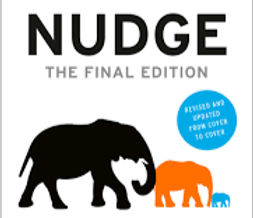
Summary
Nudge explores how small decisions can lead to huge changes in choice selection and program adoption, ultimately leading to individual- and societal-level positive outcomes. The book also provides specific guidance on how to effectively implement nudges.
The working definition of a nudge:

The authors adopt a philosophy that they have dubbed libertarian paternalism, which acknowledges that (a) people do not always make optimal decisions, and (b) it is important that people retain the freedom to make decisions for themselves. The aim of libertarian paternalism:

When you sign up for a program, fill out a survey, file taxes, shop at a physical store, or interact with any interface that asks you to make choices, the design of the survey/program/store would be called choice architecture, and the designer is a choice architect.
The design of the interface can determine what selections you make and even whether you complete a process. Examples of choice architecture include:
Program sign-ups often include a default option, which makes it much more likely to be selected
Stores put the items they most want you to buy at eye level
Some gyms allow customers to easily sign-up online, but the cancellation process requires you to print out a document and submit it via snail mail (i.e. to deter follow-through)
Though nudging can easily be used for either good or evil, the authors strongly advocate to use it only to help others make better choices, and they hope that this book also sensitizes readers to when existing choice architecture may be nudging them to make suboptimal choices.
Actionable recommendations for architects include:
If you want to encourage people to do something, make it easy.
Eliminate all possible sludge (i.e. any unnecessary logistical steps or complexities)
Make your design intentions explicit (so that you keep in mind exactly what you want folks to do)
Acknowledge and navigate common cognitive biases with which people commonly struggle, such as:
loss aversion: People are more likely to make choices to avoid a small potential loss even when the potential gain is far greater.
unrealistic optimism: People often irrationally believe that common bad outcomes will not happen to them (such as negative health developments)
My Thoughts
Nudge is excellent. As someone who frequently designs programs and forms, I’m confident that the tools I’ve learned from this book will have a substantially positive impact on future outcomes.
One of the challenges of writing on this topic is that readers can use these tools for selfish manipulation; I really appreciate how the authors openly acknowledge this reality. I don’t think there’s an easy way to safeguard against abusive nudging, but acknowledging this risk is a great first step (educating the population being the other way to inoculate against deceptive manipulation).
Historically, I’ve been very hesitant to adopt any technique that could be construed as manipulation. For anyone else that is ethically struggling with the idea of nudging, here is a rule of thumb I’ve found very effective: manipulation is simply the arrangement of things toward a goal; it is deceptive manipulation that is ethically problematic. If you are comfortable openly explaining your design choices and intentions to users, then your actions are clearly not meant to be deceptive.
My Recommendation
I strongly recommend this book to anyone who designs forms, programs, commerce platforms, or any other interface that requires people to make choices.





